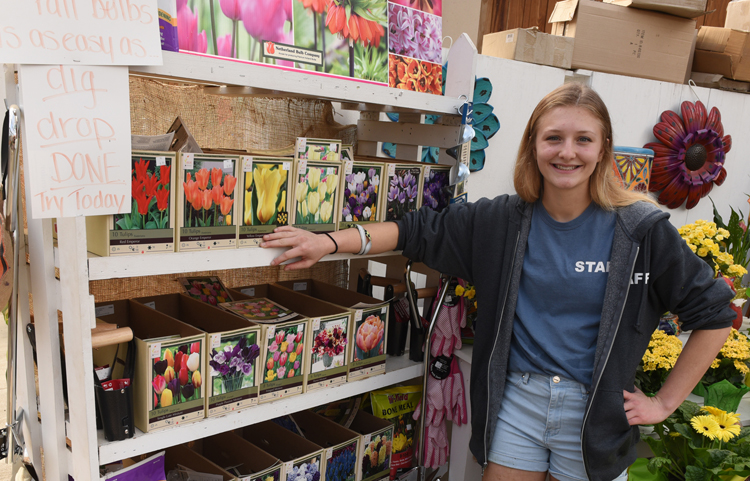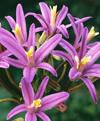Planting bulbs in the fall for spring flowers
Posted on: October 19, 2017 | Written By: Doug Oster |
Shelby Stockline and Jo-Anne van den Berg-Ohms share their passion for planting bulbs in the fall in anticipation of spring blooms, even though one has spent a lifetime immersed in bulb culture and the other is just starting her journey of discovery.
Stockline planted bulbs for the first time last fall, while van den Berg-Ohms was born into the bulb industry and now runs the family businesses, John Scheepers Beauty from Bulbs (johnscheepers.com) and Van Engelen Wholesale Bulbs (vanengelen.com) in Connecticut.

Shelby Stockline, greenhouse manager at Chapon’s Greenhouse in Baldwin, is new to bulb planting and enjoyed her first spring blooms this season.
“It’s actually quite simple to plant bulbs,” says Stockline, 21, who has worked at Chapon’s Greenhouse (412-881-1520 or chaponsgreenhouse.com) in Pittsburgh’s South Hills since her sophomore year in high school and is now greenhouse manager. “This is the perfect time to plant them.”

“I literally grew up with the bulbs in the basement,” van den Berg-Ohms says. “Every fall the house filled up with the beautiful smell of flower bulbs.”
Annually she creates a spring flower design by laying the bulbs out on prepared beds and tucking the bulbs into the ground at planting time.
“In the fall it’s part of the rhythm of my life,” she says. “I love the chill in the air and getting out there and planting. Going into the house feeling that satisfaction and the delight that I’m creating a beautiful spring for our family, I can’t imagine not doing it.”
Stockline points to a bulb auger as one of the most effective tools for getting bulbs in the ground. “You attach it to a drill which can help dig the hole easier,” she says.
Last fall, Stockline carefully chose the site for her first bulb planting experience, looking for:
- Well-drained soil
- Exposure to sun
- A location where they wouldn’t be disturbed
- A place they could easily be seen when they put on their show.
She planted parrot tulips, crocus and grape hyacinths. She fell in love with the parrot tulips just from a photo on the packaging.
“They have more color,” she says. “They have a unique style to them.”
She became overjoyed when the ‘Large Flowering Mixture’ crocus bloomed early in the season.
“In the spring it was a really nice surprise,” she says. “Those were my favorites, it was a really cool experience.”
Tips
Stockline and van den Berg-Ohms both shared some tips for bulb planting. One things to remember is something van den Berg-Ohms’ father taught her, “As long you are planting them in a place where they are going to be happy, they do everything they need to do all by themselves.”
Size: Look for the biggest and firmest bulbs and purchase in quantity to create an amazing drift of flowers. Size is especially important when looking for daffodils as the more “noses” a bulbs has, the more flowers should emerge in the spring. Some bulbs might even produce three daffodil flowers.
Digging: The general rule of thumb is to plant a bulb about three times as deep as the bulb itself.
Fertilizing: The only fertilization van den Berg-Ohms does is after they are planted and never adds anything to the bottom of the hole as it can cause root burn. She’ll broadcast a bulb fertilizer over the top of the soil above newly planted bulbs.
Timing: The bulbs can be planted until the ground freezes solid. Van den Berg-Ohms, however, has planted through the snow and even during a January thaw.
Keeping out critters: As far as moles, voles and other animals are concerned, van den Berg-Ohms is willing to share a little and doesn’t worry about them. “I think regardless of what the issue might be, Mother Nature always wins. Whatever I think I can do to outsmart animals, I think all I’m doing is making a smarter generation of rodents for the future,” she says with a laugh.
Picking bulbs
Snowdrops: One of the first bulbs to bloom are snowdrops. “I’ve seen them covered in a foot of snow, van den Berg-Ohms says, and sure enough they come right back after the late snow melts.” ‘Flore Pleno’ has a pretty double white flower that can bloom as early as January if the weather cooperates.

Fritillaria meleagris
Fritillaria: This hardy bulb is a little off the beaten path, but well worth growing, she says. “The crown imperialis and Fritillaria persica are probably the two large varieties that come to mind,” she says. Of the smaller varieties, Fritillaria meleagris has beautiful mottled purple and white flowers. The genus can be a little finicky, favoring a wet spring, very dry summer and well-drained soil. “When they like where they are planted, they are such an incredible showstopper in the garden, they can just take your breath away.”
Daffodils: “Narcissus ‘Lingerie’ is the most opulent, fully formed double narcissus,” van den Berg-Ohms says. “It has beautifully sculpted outer and inner layers of petals. As you get in towards the center of it, it has the whirled petaloid segments as well. The flower petals are this beautiful ivory color with a bit of a yellow glimmer.” Other daffodils recommendations include ‘Pink Charm,’ ‘Bell Song and the double ‘Delnashaugh.’
Bluebells: Hyacinthoides hispanica (Spanish bluebells) are an incredible perennial, she says. ‘Excelsior,’ ‘Dainty Maid’ and ‘White City’ are a few of her other favorites.

Allium caesium
Alliums: ‘Globemaster,’ ‘Gladiator’ and ‘Ambassador,’ with their large purple globular flowers, are probably the best known varieties. But there are wide ranging sizes and colors. Pests rarely bother them since they are from the onion family. “Allium caesium is fabulous,” van den Berg-Ohms says of the plant’s 3-inch sky blue flowers. “That blue in the garden is so incredible and if you plant a thick drift of those, it’s magical.” She also has grown them along side the white flowering Allium amplectens ‘Graceful Beauty.’
Brodiaea: “Most people have never heard of it,” van den Berg-Ohms says. “They are absolutely fabulous, and they come up at a time when there aren’t that many summer perennials in bloom.” They have thin, wiry stems, with flowers that offer diverse shapes and colors that “dance towards the sun,” she says. They are hardy to zone 6 (Western Pennsylvania’s zone), and she has had success growing them in one zone colder. Other varieties to experiment with include deep blue Brodiaea laxa ‘Corrina’ or pink Brodiaea californica ‘Babylon.’

Brodaiea californica ‘Babylon’
Tulips: Gardeners usually get a few seasons out of tulips bulbs. She says to grow them as annuals. Even though her great uncle introduced Darwin tulips to the United States in the 1950s, which are often marketed as perennial tulips, they don’t always perform as well as advertised. “They might come back for more years than not, but the flowers do peter out and they do get smaller in stature over the years,” she says. Her favorite tulip is ‘Dordogne.’ “It’s this combination of pink, rose, apricot, orange, it looks different every time you look at it. I can’t imagine not having ‘Dordogne’ in my life, I adore her.”
Have some patience

Tulip ‘Dordogne’
Even though planting bulbs doesn’t offer the instant gratification many gardeners crave, the tradition continues. Spring just wouldn’t be the same without the color these flowers provide.
“It’s just such a terrific feeling as the days start getting a little bit less dark and short, just to be able to go to a couple windows in the house and see if the galanthus (snowdrops) are braving their little noses up through the frosty soil yet,” van den Berg-Ohms says. “Just waiting and watching, it feels like a surprise party about to happen, I just adore it. It still is magic to me.”
Doug Oster is editor of Everybody Gardens, a website operated by 535Media, LLC. Reach him at 412-965-3278 or doster@535mediallc.com. See other stories, videos, blogs, tips and more at everybodygardens.com.
More from Everybody Gardens
See also, Tips On How To Grow Succulents Indoors